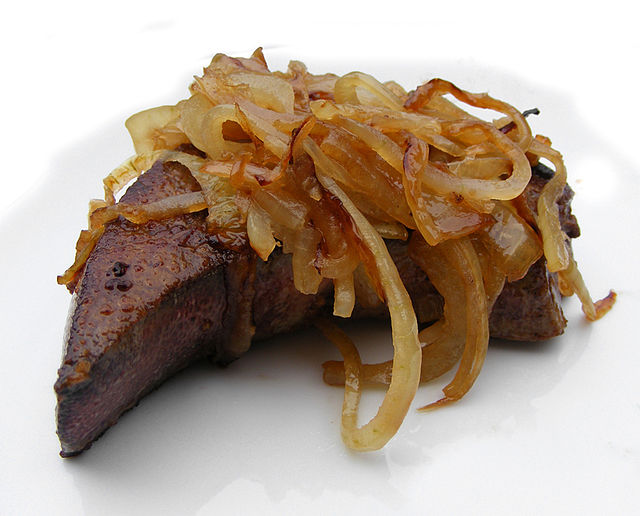Liver (food)
Liver meat used as food From Wikipedia, the free encyclopedia
The liver of mammals, fowl, and fish is commonly eaten as food by humans (see offal). Pork, lamb, veal, beef, chicken, goose, and cod livers are widely available from butchers and supermarkets while stingray and burbot livers are common in some European countries.



Nutrition
Summarize
Perspective
| Nutritional value per 100 g (3.5 oz) | |||||||||||||||||||||||||||||||||
|---|---|---|---|---|---|---|---|---|---|---|---|---|---|---|---|---|---|---|---|---|---|---|---|---|---|---|---|---|---|---|---|---|---|
| Energy | 561 kJ (134 kcal) | ||||||||||||||||||||||||||||||||
2.5 g | |||||||||||||||||||||||||||||||||
3.7 g | |||||||||||||||||||||||||||||||||
21 g | |||||||||||||||||||||||||||||||||
| |||||||||||||||||||||||||||||||||
This nutritional data is from 1992 and refers to raw pork liver only. Liver nutrients vary among species. | |||||||||||||||||||||||||||||||||
| †Percentages estimated using US recommendations for adults,[1] except for potassium, which is estimated based on expert recommendation from the National Academies.[2] | |||||||||||||||||||||||||||||||||
Animal livers are rich in iron, copper, B vitamins and preformed vitamin A. Daily consumption of liver can be harmful; for instance, vitamin A toxicity has been proven to cause medical issues to babies born of pregnant mothers who consumed too much vitamin A.[3] For the same reason, consuming the livers of some species like polar bears, dogs, or moose is unsafe. A single slice (68 g) of beef liver exceeds the tolerable upper intake level of vitamin A (6410 μg preformed vs. UL for preformed = 3000 μg).[4] 100 g cod liver contains 5 mg of vitamin A and 100 μg of vitamin D.[5] Liver contains large amounts of vitamin B12, and this was one of the factors that led to the discovery of the vitamin.[6]
Etymology
From Middle English liver, from Old English lifer, from Proto-Germanic *librō, from Proto-Indo-European *leyp- "to smear, smudge, stick", from Proto-Indo-European *ley- "to be slimy, be sticky, glide". Cognate with Saterland Frisian Lieuwer "liver", West Frisian lever "liver", Dutch lever "liver", German Leber "liver", Danish, Norwegian and Swedish language lever "liver" the last three from Old Norse lifr "liver".
In the Romance languages, the anatomical word for "liver" (French foie, Italian fegato, Spanish hígado, etc.) derives not from the Latin anatomical term, jecur, but from the culinary term ficatum, literally "stuffed with figs", referring to the livers of geese that had been fattened on figs (foie gras).[7]
Preparation
Liver can be baked, boiled, broiled, fried, stir-fried, or eaten raw (asbeh nayeh or sawda naye in Lebanese cuisine, liver sashimi). In many preparations, pieces of liver are combined with pieces of meat or kidneys, like in the various forms of Middle Eastern mixed grill (e.g. meurav Yerushalmi). Spreads or pâtés made from liver have various names, including liver pâté, pâté de foie gras, chopped liver, liverwurst, liver spread, and Braunschweiger. Other liver sausages include mazzafegato or salsiccia matta. A traditional South African delicacy, namely skilpadjies, is made of minced lamb's liver wrapped in netvet (caul fat), and grilled over an open fire.
Fish liver
Some fish livers are valued as food, especially the stingray liver. It is used to prepare delicacies, such as poached skate liver on toast in England,[8] as well as the beignets de foie de raie and foie de raie en croute in French cuisine.[9] Cod liver (usually tinned in its oil and served seasoned) is a popular spread for bread or toast in several European countries. In Russia, it is served with potatoes. Cod liver oil is commonly used as a dietary supplement. Liver of burbot is eaten in Finland: it is common for fish vendors and supermarket fish aisles to sell these fish with liver and roe sacks still attached. These parts are often eaten boiled or added to burbot soup. Burbot and its liver are a traditional winter food.[10]
Poisoning
Summarize
Perspective
The livers of polar bears, walruses, bearded seals, and huskies can contain very high levels of preformed vitamin A,[11] and their consumption has led to vitamin A poisoning (hypervitaminosis A) according to several anecdotal reports. It has been estimated that consumption of 500 grams of polar bear liver would result in a toxic dose for a human.[11] Russian sailor Alexander Konrad, who accompanied explorer Valerian Albanov in a tragic ordeal over the Arctic ice in 1912, wrote about the awful effects of consuming polar bear liver.[12] Also, in 1913, Antarctic explorers on the Far Eastern Party Douglas Mawson and Xavier Mertz were believed to have been poisoned, the latter fatally, from eating husky liver, though this claim has been recently contested.[13]
Mercury content in some species can also be an issue. In 2012, the Government of Nunavut, Canada warned pregnant women to lower their intake of ringed seal liver due to elevated levels of organomercury.[14]
The neurotoxin in the liver of the pufferfish (which is consumed in Japanese cuisine as fugu, tightly regulated by Japanese law) contains the highest concentration of the tetrodotoxin, which characterizes the species. Consequently, the liver has been illegal to serve since 1984.
Traditions
Pig liver is a traditional food of immigrant Okinawans in Hawaii. It used to be eaten on New Year's Eve.[15]
In Pakistan and North India, the liver is eaten traditionally as the first meat of the sacrificial animal during Eid al-Adha. Kaleji masala or kaleji salan is popular throughout the festival.[16]
See also
References
Wikiwand - on
Seamless Wikipedia browsing. On steroids.
